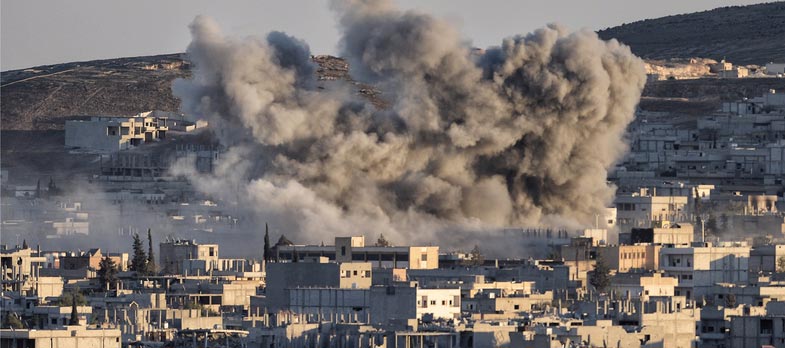Fighters from Malhama Tactical, a small organization of private military contractors who are the latest self-proclaimed protectors of oppressed Sunni minorities all over the globe, are the newest such warriors to arrive in Syria.
Little is known about their leader, Abu Rofiq, a pseudonym that means “father of Rofiq.” He is apparently a 24-year-old jihadist from Uzbekistan, and many of the nine other fighters in his organization hail from Russian Caucasus republics, including Kazakhstan, Turkmenistan, and Tajikistan. He is prominently featured in many YouTube videos that include Cyrillic script and a nasheed soundtrack; Mr. Rofiq always conceals his face on camera. The group first appeared in May 2016, supplementing ISIS’s operations against moderate Syrian leader Bashar al-Assad, with the ultimate goal of establishing a much more conservative theocratic Islamist regime. In addition to battlefield operations, Malhama Tactical also provides training and tactical support services. During a recent interview, Mr. Rofiq hinted that the group might soon look outside Syria to other potential hotspots, such as Myanmar and China.
As part of an expansion effort, the group posted an ad on Facebook last November, promising benefits such as paid vacation, a weekly day off, the chance to join a “fun and friendly team,” and the opportunity to “constantly engage, develop, and learn.”
Private Military Contractors in Syria
In 2013, the Slavonic Corps became the first private military contractor group to intervene in Syria, and that is using the term loosely. The ex-Russian service members theoretically fought on behalf of Assad’s government, but apparently never had an official mission. The Syrian army confiscated the group’s vehicles, then the government apparently confiscated their paychecks. When the remains of the group returned home after a disastrous defeat near Sukhnah, the Russian Federal Security Service arrested the men for their unsanctioned intervention.
Over 1,000 Russian mercenaries from the shadowy Wagner Group arrived in 2015. Dmitry Utkin, a former Russian special ops officer, models the group after Academi, as the mercenaries rely extensively on the Russian government.
The Wagner Group fights alongside Russian military units attempting to prop up Assad. However, almost 5,000 other Russian mercenaries are fighting to destabilize Assad; most of these warriors are from Dagestan and Chechnya. They are highly sought-after allies among ISIS fighters, as these mercenaries are usually better equipped and more experienced than local militia elements.
Currently, there are no American private military contractors in country, but that could change soon, as the Trump administration appears poised to commit ground forces in Syria. According to the Pentagon, their overall mission would be would be a two-pronged approach, fighting ISIS forces and Kurdish rebels who may threaten Turkey. Lawmakers did not ask Defense Secretary James Mattis about possible ground forces in Syria during his confirmation hearing, but Gen. Mattis did say that the administration would pursue “a more accelerated campaign” in the war-torn country.
The situation is extremely chaotic, as administration officials may also seek cooperation with Russian fighters, and that cooperation might include arming some Kurdish groups in the north.
Compensation for Injured Contractors
The devastating Syrian civil war has now dragged on for over six years and killed over 400,000 men, women, and children. In such a hazardous environment, a broad and effective injury compensation system is essential to give contractors the confidence they need to carry out necessary operations. That is where the Defense Base Act comes in.
To be eligible for compensation, victims must be injured in country while engaged in an activity reasonably related to their military contractor service. So, in addition to injuries that occur during their shifts, injured contractors are also eligible for benefits if they are injured in attacks on their barracks or are ambushed on their way to or from their posts. They could also receive benefits even if not working under the doctrine of “zone of special danger” which essentially affords coverage 224 hours/day.
For more information about available DBA benefits, contact Barnett, Lerner, Karsen & Frankel.

